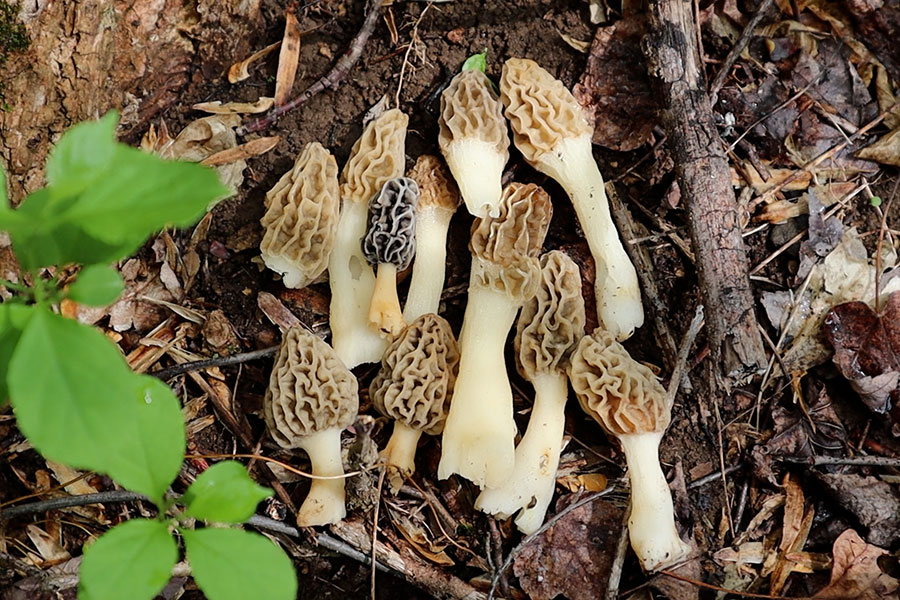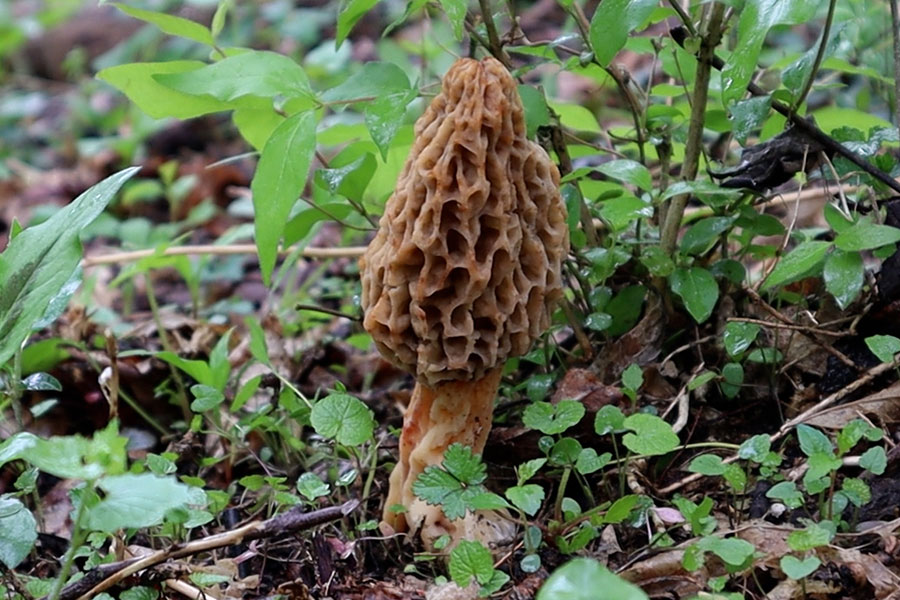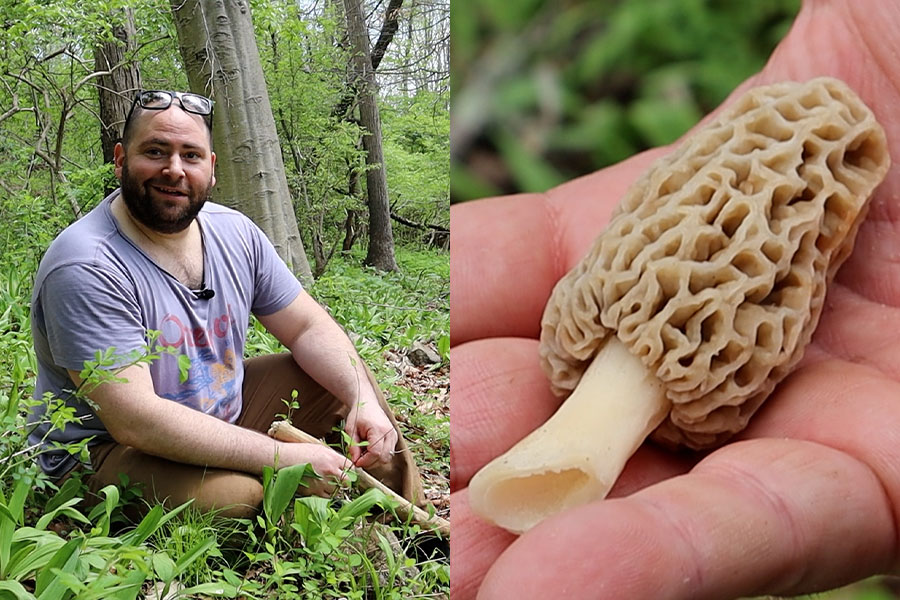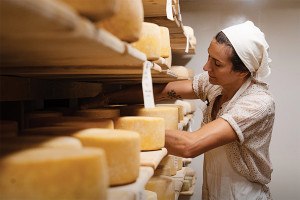Want to Find Morels? A Philly Chef Shares His Secrets
Chef Chris D'Ambro of Ambra and Southwark took our food editor on a hunt for one of the season's rarest foraged ingredients. Here's what they found.

Morel mushrooms / Photography by Kae Lani Palmisano
It’s early on a Saturday morning, and chef Chris D’Ambro, his wife Marina de Oliveira, their friends Amelia Runyan and Karl Recktenwald, and I are in Ridley Creek Park hunting for one of spring’s most sought-after ingredients: morels.
Shortly after D’Ambro led us off-trail, we find one — a massive, no-less-than-four-inch-tall honeycomb monolith jutting from the damp soil. “This is one of the biggest ones we’ve ever found on this hill,” he says, picking the prized mushroom off the ground. These choice edibles are a favorite on the menu at both Ambra and Southwark, the two adjoining restaurants D’Ambro and de Oliveira own.
The menu at Ambra is constantly changing and often features seasonal ingredients the couple forages in their time off. For the next few weeks, the multi-course menu is kicking off with a fried morel, chicken, and marrow sausage with onion agrodolce and smoked egg yolk bottarga. Diners are also in for a treat when the fifth course comes around: doppio ravioli with braised pork and morel polenta filling, fermented leek butter, fresh black truffle, and focaccia. At Southwark, which shares a kitchen with Ambra, you’ll find a pea and ricotta ravioli with morels, lemon, house-made bacon, pea leaves, and cured egg yolk on the menu.
Most foragers are secretive about their spots, but not D’Ambro. “I tell people all of the time where I go picking,” he says. “They’re never fucking finding this shit anyway.” He’s not wrong. One does not simply wander into the woods and stumble upon a treasure trove. Morels are elusive — a challenge to find even for skilled foragers. It can take several seasons of leaving the forest empty-handed before figuring out the precise conditions they require to bloom.
D’Ambro, for instance, spent four springs rooting around in the wet, fallen leaves before finding his first morel. He knew when to find them — during a short three-week window from late March through April, preferably after it rains and when the soil temperature creeps up to around 50 degrees Fahrenheit — but it took him years to figure out where to find them. That part of the equation is equally complicated.
Morel hunting is like playing double-dutch with nature, but instead of skipping with two ropes, you’re trying to fall in step with the seasons, the weather, the terroir, and all of the idiosyncrasies of many the different microclimates within a given area. D’Ambro could give you the exact coordinates of his foraging spots, but if the conditions aren’t in alignment you’ll turn up zilch.
The Science of Morel Hunting

The largest morel find of the day
Everyone I ventured into the forest with has their own morel hunting strategy. Recktenwald tells me he follows deer trails. “When you start seeing deer poop, you’re close by,” he says. It makes sense. Deer love morels just as much as humans do. In fact, they’re considered a mushroom hunter’s biggest competition. Follow the poop trails, and you can usually find a few they missed.
D’Ambro, on the other hand, looks up, searching the tree canopy for ash, elm, and tulip poplar trees — all trees that seem to have a symbiotic relationship with morels.
Instead of feeding on decaying organic matter like most organisms in the fungi kingdom, there’s a school of thought that classifies morels as a mycorrhizal mushroom, along with chanterelles, porcini, and even truffles. These mushrooms have a massive underground mycelium network that attaches itself to the tree’s roots, taking the carbohydrates it needs and, in return, giving water and mineral nutrients back to the tree — essentially acting as an extension of the tree’s root system. This relationship — the delicate balance of give and take — makes it extremely hard to predict where and when morels will sprout. It’s also the same reason why cultivating morels commercially is particularly challenging.
Elevation plays a role, too, as does what side of the hill you’re on. Even if you’ve found the right trees (or a fresh pile of deer poop), if you’re on the north-facing side of a hill that doesn’t see much sun or at too high of an elevation where the soil temperature hasn’t hit that sweet spot of 50 degrees Fahrenheit, you likely won’t find any morels. D’Ambro recommends trudging around in areas that get a lot of sunlight, preferably south-facing. Once you find a morel, chances are you’ll continue to find them around that same elevation. If you come back to your mushroom hunting spot week after week, you’ll see the morels move uphill as the soil temperature at higher elevations rises.
The Thrill of the Hunt

Chef Chris D’Ambro of Ambra and Southwark, and a large morel mushroom he found
Their fickle nature is part of the reason why morels have become highly valued in recent years, especially within culinary circles. Depending on the season, morels can go for around $20 per pound. For perspective, our foraging party of five spent four hours rummaging through the forest and found roughly two pounds of morels — and that was a good day according to D’Ambro. Though there are some economic incentives to finding these choice edibles, many forage for more intrinsic reasons.
“There’s not too many ingredients you get to connect with in a way where you can literally go pick it and serve it sometimes the same day. It’s a nice way to make a special dinner even more special,” D’Ambro says. “Even if we come back empty-handed, it’s nice to get out of the city. It’s nice to be out in nature.”
The thrill of the hunt for morels is as much about the find as it is about reconnecting with nature, listening to the Earth’s cues, and falling in step with its annual rhythms. Their rarity, the fleeting season, the variable conditions required to make them bloom, their elusive nature, and the fact that deer haven’t gobbled up the morels first make finding them all the more special. Every morel represents a moment of being in tune with nature. After my first hunt, I totally understood the hype.
“What do you feel when you find a morel?” I ask D’Ambro.
“Joy,” he says. “Childish joy. It is literally the closest thing to being a kid.”
What to Bring on Your Morel Hunt
If you’re planning on foraging for morels, be ready to get down and dirty. Morels are often hiding underneath leaves and debris on the forest floor. You’ll likely be going off-trail and crawling around the brush, so wear long pants and high socks to prevent tick bites, and don’t forget to check for ticks when you go home.
To save yourself from crouching down all day, D’Ambro recommends getting a stick so you can push fallen foliage out of the way without bending over. You’ll also want to bring a small foraging knife to cut the mushroom’s stem just above the soil line, as well as a mesh bag to carry your foraged finds. The mesh bag will not only keep your morels fresh but will help spread spores as you’re hiking through the forest, so you can keep coming back for more year after year.


